利用seaborn、statannotations库绘制显著性标注

如何使用Python-SeabornSeaborn进行显著性统计图表绘制,详细内容如下:
1、Python-Seaborn 自定义函数绘制
import matplotlib.pylab as plt
import numpy as np
import seaborn as sns
import scipy# ---------------------自定义P值和星号对应关系----------------------
def convert_pvalue_to_asterisks(pvalue):if pvalue <= 0.0001:return ""elif pvalue <= 0.001:return "*"elif pvalue <= 0.01:return ""elif pvalue <= 0.05:return "*"return "ns"# ---------------------scipy.stats 计算显著性指标----------------
iris = sns.load_dataset("iris")
data_p = iris[["sepal_length","species"]]
stat,p_value = scipy.stats.ttest_ind(data_p[data_p["species"]=="setosa"]["sepal_length"],data_p[data_p["species"]=="versicolor"]["sepal_length"],equal_var=False)# ------------------------可视化绘制---------------------------
plt.rcParams['font.family'] = ['Times New Roman']
plt.rcParams["axes.labelsize"] = 18
palette=['#0073C2FF','#EFC000FF','#868686FF']fig,ax = plt.subplots(figsize=(5,4),dpi=100,facecolor="w")
ax = sns.barplot(x="species",y="sepal_length",data=iris,palette=palette,estimator=np.mean,ci="sd", capsize=.1,errwidth=1,errcolor="k",ax=ax,{"edgecolor":"k","linewidth":1})
# 添加P值
x1, x2 = 0, 1
y,h = data_p["sepal_length"].mean()+1,.2
#绘制横线位置
ax.plot([x1, x1, x2, x2], [y, y+h, y+h, y], lw=1, c="k")
#添加P值
ax.text((x1+x2)*.5, y+h, "T-test: {} ".format(p_value), ha='center', va='bottom', color="k")ax.tick_params(which='major',direction='in',length=3,width=1.,labelsize=14,bottom=False)
for spine in ["top","left","right"]:ax.spines[spine].set_visible(False)
ax.spines['bottom'].set_linewidth(2)
ax.grid(axis='y',ls='--',c='gray')
ax.set_axisbelow(True)
plt.show()
2、Python-statannotations库添加显著性标注
Python-statannotations库则是针对Seaborn绘图对象进行显著性标注的专用库,其可以提供柱形图、箱线图、小提琴图等统计图表的显著性标注绘制,计算P值方法基于scipy.stats方法,这里我们简单列举几个示例演示即可,更多详细内容可参看:项目地址、使用教程 or Seaborn。
样例一:
import seaborn as sns
import matplotlib.pylab as plt
from statannotations.Annotator import Annotatordf = sns.load_dataset("tips")x = "day"
y = "total_bill"
order = ['Sun', 'Thur', 'Fri', 'Sat']
fig,ax = plt.subplots(figsize=(5,4),dpi=100,facecolor="w")
ax = sns.boxplot(data=df, x=x, y=y, order=order,ax=ax)pairs=[("Thur", "Fri"), ("Thur", "Sat"), ("Fri", "Sun")]
annotator = Annotator(ax, pairs, data=df, x=x, y=y, order=order)
annotator.configure(test='Mann-Whitney', text_format='star',line_height=0.03,line_width=1)
annotator.apply_and_annotate()ax.tick_params(which='major',direction='in',length=3,width=1.,labelsize=14,bottom=False)
for spine in ["top","left","right"]:ax.spines[spine].set_visible(False)
ax.spines['bottom'].set_linewidth(2)
ax.grid(axis='y',ls='--',c='gray')
ax.set_axisbelow(True)
plt.show()
样例二:
import seaborn as sns
import matplotlib.pyplot as plt
plt.rcParams['font.family'] = ['Times New Roman']
plt.rcParams["axes.labelsize"] = 18
#palette=['#0073C2FF','#EFC000FF']
palette=['#E59F01','#56B4E8']
#palette = ["white","black"]fig,ax = plt.subplots(figsize=(5,4),dpi=100,facecolor="w")
ax = sns.barplot(x="order",y="value",hue="class",data=group_data_p,palette=palette,ci="sd",capsize=.1,errwidth=1,errcolor="k",ax=ax,{"edgecolor":"k","linewidth":1})# 添加P值
box_pairs = [(("one","type01"),("two","type01")),(("one","type02"),("two","type02")),(("one","type01"),("three","type01")),(("one","type02"),("three","type02")),(("two","type01"),("three","type01")),(("two","type02"),("three","type02"))]annotator = Annotator(ax, data=group_data_p, x="order",y="value",hue="class",pairs=box_pairs)
annotator.configure(test='t-test_ind', text_format='star',line_height=0.03,line_width=1)
annotator.apply_and_annotate()
样例三:如果针对组间数据进行统计分析,可以设置pairs参数据如下:
box_pairs = [(("one","type01"),("one","type02")),(("two","type01"),("two","type02")),(("three","type01"),("three","type02"))]
案例四:自定义显著性
import seaborn as sns
import matplotlib.pylab as plt
from statannotations.Annotator import Annotatordf = sns.load_dataset("tips")x = "day"
y = "total_bill"
order = ['Sun', 'Thur', 'Fri', 'Sat']
pairs = [("Sun", "Thur"), ("Sun", "Sat"), ("Fri", "Sun")]
ax = sns.boxplot(data=df, x=x, y=y, order=order)
annot = Annotator(ax, [("Thur", "Fri"), ("Thur", "Sat"), ("Fri", "Sun")], data=df, x=x, y=y, order=order)
annot.new_plot(ax, pairs=pairs, data=df, x=x, y=y, order=order)
annot.configure(test=None, loc='inside')
annot.set_pvalues([0.1, 0.1, 0.001])
annot.annotate()
plt.show()
3、Python-statannotations库绘制显著性标注并自己设置标识
在安装的statannotations库文件夹下找到 PValueFormat.py文件并打开
找到下面这个函数,你可以通过修改这个函数添加自己想要的标识效果

4、相关性热力图自动标记显著性
import pandas as pd
import seaborn as sns
import matplotlib.pyplot as plt
import numpy as np
from scipy.stats import pearsonr
import matplotlib as mpldef cm2inch(x,y):return x/2.54,y/2.54size1 = 10.5
mpl.rcParams.update(
{
'text.usetex': False,
'font.family': 'stixgeneral',
'mathtext.fontset': 'stix',
"font.family":'serif',
"font.size": size1,
"font.serif": ['Times New Roman'],
}
)
fontdict = {'weight': 'bold','size':size1,'family':'SimHei'}df_coor=np.random.random((10,10)) # 相关性结果
fig = plt.figure(figsize=(cm2inch(16,12)))
ax1 = plt.gca()#构造mask,去除重复数据显示
mask = np.zeros_like(df_coor)
mask[np.triu_indices_from(mask)] = True
mask2 = mask
mask = (np.flipud(mask)-1)*(-1)
mask = np.rot90(mask,k = -1)im1 = sns.heatmap(df_coor,annot=True,cmap="RdBu"
, mask=mask#构造mask,去除重复数据显示
,vmax=1,vmin=-1
, fmt='.2f',ax = ax1)ax1.tick_params(axis = 'both', length=0)#计算相关性显著性并显示
rlist = []
plist = []
for i in range(df_coor.shape[0]):for j in range(df_coor.shape[0]):r,p = pearsonr(df_coor[i],df_coor[j])rlist.append(r)plist.append(p)rarr = np.asarray(rlist).reshape(df_coor.shape[0],df_coor.shape[0])
parr = np.asarray(plist).reshape(df_coor.shape[0],df_coor.shape[0])
xlist = ax1.get_xticks()
ylist = ax1.get_yticks()widthx = 0
widthy = -0.15for m in ax1.get_xticks():for n in ax1.get_yticks():pv = (parr[int(m),int(n)])rv = (rarr[int(m),int(n)])if mask2[int(m),int(n)]<1.:if abs(rv) > 0.5:if pv< 0.05 and pv>= 0.01:ax1.text(n+widthx,m+widthy,'*',ha = 'center',color = 'white')if pv< 0.01 and pv>= 0.001:ax1.text(n+widthx,m+widthy,'',ha = 'center',color = 'white')if pv< 0.001:print([int(m),int(n)])ax1.text(n+widthx,m+widthy,'*',ha = 'center',color = 'white')else:if pv< 0.05 and pv>= 0.01:ax1.text(n+widthx,m+widthy,'*',ha = 'center',color = 'k')elif pv< 0.01 and pv>= 0.001:ax1.text(n+widthx,m+widthy,'',ha = 'center',color = 'k')elif pv< 0.001:ax1.text(n+widthx,m+widthy,'*',ha = 'center',color = 'k')
plt.show()


